There are so many incredible Australian native plants that can offer fantastic, hassle-free landscaping opportunities. Kunzea plants are often a popular choice for their many stunning blooming habits.
Kunzea ambigua, or Tick Bush, is one such species that is grown for its fragrant flowers but also its helpful essential oils. If you’re looking to add another Australian native to your garden landscape, here’s what you need to know to start growing Kunzea ambigua at home.
More...
What is Kunzea ambigua?
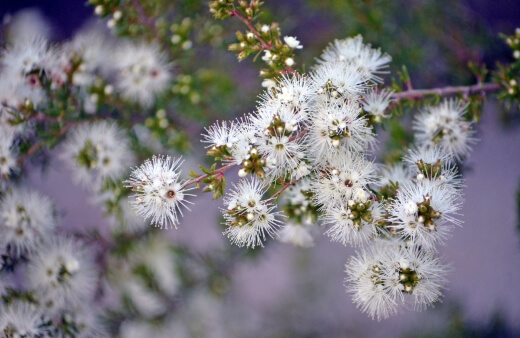
Kunzea ambigua is a perennial, evergreen shrub that has a curious weeping habit, green foliage and clumps of sweet-smelling white flowers. Part of the Myrtaceae family, this species of Kunzea grows naturally along the Southeast coast of Australia.
The Kunzea genus derives its name from the well-known German botanist Gustave Kunze. The species name, ambigua, derives from the Latin word for obscure, which alludes to the plant’s weeping growth habit.
Other common names for Kunzea ambigua includes:
- White Kunzea
- White Cloud
- Tick Bush
- Poverty Bush
Why is it Called Tick Bush?
The Kunzea ambigua naturally produces a very fragrant essential oil. One can often find native animals sleeping underneath tick bushes as relief from ticks and other parasites in the wild.
Today, the oil of the ambigua is used as a powerful tick repellent. This essential is also used for the treatment of eczema, skin rashes, muscular aches, arthritis, and rheumatism.
How to Start Growing Kunzea ambigua
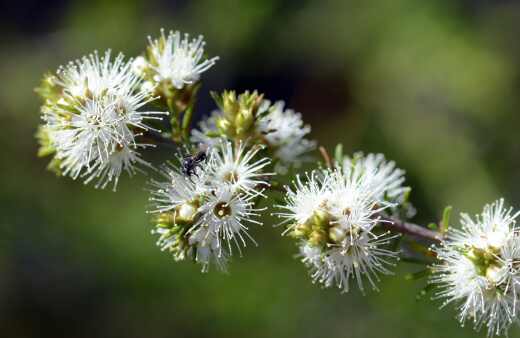
White kunzea is an incredible fuss-free plant. As it’s drought and frost tolerant, once established, it won’t require any extra attention.
Kunzea ambigua can be grown in a variety of environments and only requires a light, sant and well-draining soil. It can be grown as part of a rock garden, as a screening plant, as a windbreak or even smaller bonsai plant.
As white kunzea requires a significant amount of daily sunlight in order to flower, it’s best to grow it outdoors. Pick a spot that receives plenty of morning or afternoon sun. In general, it needs at least 4 hours of direct sunlight.
How to Propagate Kunzea ambigua
Tick bush can be easily propagated from readily available seeds or hardwood tip cuttings.
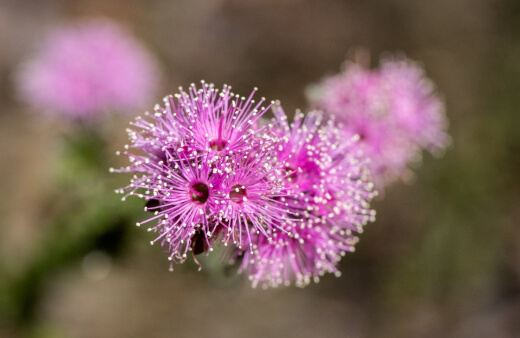
From Seed
- Most gardeners will not recommend propagation from seed as the seeds of the Myrtaceae species require heat to germinate and can remain dormant for many years.
- The ideal germination temperature is between 18-22°C.
- Sow the seeds directly onto the surface of a porous seeding mix.
- Pour water over the seeds, allowing them to lodge. Then gently sprinkle with a small amount of soil.
- Seeds should germinate between 14 to 28 days; however, it can take longer, so just be patient.
From Cutting
- Cuttings can be taken from existing healthy tick bush plants. Be sure to use a sterilized grafting knife to avoid the transmission of any diseases.
- Cutting should be taken during late spring.
- Once removed from the original plant, dip the cut end into a commercial rooting hormone and then into a porous seeding mix.
Tips for Kunzea ambigua Care
There really isn’t much you’ll need to do when it comes to Kunzea ambigua care. It usually handles itself incredibly well in normal outdoor conditions, especially in coastal regions.
When grown outside, it will require little to no additional water beyond the natural rainfall. Fertiliser can be added to support plant growth. A general-purpose fertiliser can be applied during spring.


Get Your Free Guide:
Master Growing Australian Natives eBook
A Must Have Complete Guide for Every Australian Garden
Get Your Free Guide:
Master Growing Australian Natives eBook
A Must Have Complete Guide for Every Australian Garden
The only major care aspect you’ll need to consider is occasional pruning. When left to grow, white kunzea can grow as much as 3 metres tall and 5 metres wide.
However, many gardeners prefer to keep this species as a smaller growing shrub. Regular pruning will help you to keep it smaller and in shape.
Should you be growing this species as a smaller indoor plant or as a bonsai, some growers recommend repotting on a yearly basis, usually in the spring or fall.
Pests, Problems & Diseases
This species is incredibly hardy and is resistant to most common garden pests and diseases. The only commonly complained about issue is the webbing caterpillar which may frequent your tick bush.
Luckily, webbing caterpillars can easily be controlled through physical removal or by a commercial insecticide.
Other Interesting Kunzea Facts
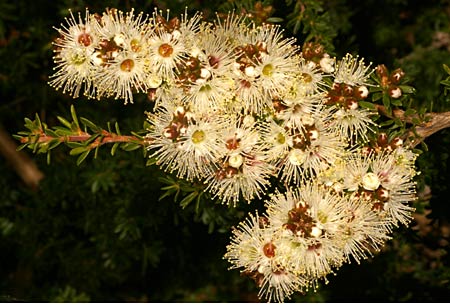
- Although known for its big white blooms, a pink-flowered variety is also in cultivation.
- The form of growth can be controlled through training. Using a wire, you can control the shape but be sure to begin wiring only when the branches are young and pliable so as not to damage the plant.
- The leaves of the white kunzea are very sweet-scented and can be used to add a strong flavour to teas or to cooking. Apparently, it pairs well with roast meat and vegetables.
- Kunzea ambigua is also a honey-producing plant. In many parts of Tasmania, kunzea honey is readily available.
Kunzea ambigua Frequently Asked Questions
What is Kunzea essential oil used for?
Kunzea essential oil is used to relieve mild anxiety, stress and nervous tension or nervousness. The powerful essential oil is generally considered a useful herbal remedy for many nervous disorders and as a calming supplement.
Why is Kunzea called the tick bush?
K. ambigua, or the tick bush, gets its name as a common shelter plant for ticks and mites. The small insects seek shelter from harsh weather conditions in their native environment and can be found in large numbers in spring and summer around the leaves and branches.
Is Kunzea ambigua native to Australia?
K. ambigua is native to North East Tasmania, where it can cope with harsh and changeable climate patterns, high winds and salty air. The bush is often the only substantial shrub in its landscape, growing in fields or dry grass and low growing brush.
Is Kunzea ambigua the same as Tasmanian spring flower?
Tasmanian spring flower is another name for K. ambigua, or the tick Bush, also commonly called White Cloud bush thanks to its fluffy white blooms in spring.
All names are commonly applied to the essential oil, which is the same preparation in all cases.
Is Kunzea safe?
K. ambigua is a safe and non-toxic plant to have in the garden. The essential oil is often used as herbal remedy for anxiety and mood disorders.
Gardeners with sensitive skin may get rashes from the low concentrations of cineole, but when prepared, the concentration is so low in essential oils that it is safe for anyone without allergies.
Is Kunzea oil anti-inflammatory?
There are some reports online that Kunzea oil can be used as an anti-inflammatory treatment for muscular pain, but this is largely untested and unproven. You can purchase Kunzea oil treatments for pain relief in pharmacies and health food stores.
How fast does Kunzea grow?
K. ambigua can regrow about 1-1.5m tall each year. Once the flowers and foliage are harvested the plant continues to grow. Young plants are fast to establish, and can reach 1-2m in their first year.
Does Kunzea help arthritis?
Kunzea essential oil can temporarily relieve symptoms of arthritis and rheumatism. It isn’t unusual to find it for sale in massage rooms, or in the tool kits of massage therapists for this reason.
If nothing else, the aroma is enough to settle your mind and relax so you can properly understand your pain.
How big does Kunzea grow?
K. ambigua can reach 5m tall in cultivation, but due to the harsh natural habitat of coastal Tasmania, it is usually found growing at 2-3m tall in the wild – likely as a coping mechanism to minimise wind damage.
Is Kunzea a tea tree?
Kunzea is a unique genus, and while it is similar to tea tree, they are distinct genera. The fragrance of Kunzea is often compared to tea trees.
What does Kunzea smell like?
Kunzea leaves, and Kunzea essential oil, have a distinct eucalyptus-like aroma, but with a deeper, woodier scent underlying. The sweet, spicy notes that tie the fragrance together make it less harsh than tea tree of eucalyptus, and are more calming than the traditional cold remedy.
What part of the plant makes Kunzea essential oil?
Essential oils are present in every part of K. ambigua, but the highest concentrations are in the stems and leaves of these fragrant shrubs. Like most herbs, rubbing the leaves will release the odour, but so will scratching the bark or crushing flower petals.
Essential oil is extracted through steam distillation of the stems and leaves of K. ambigua.
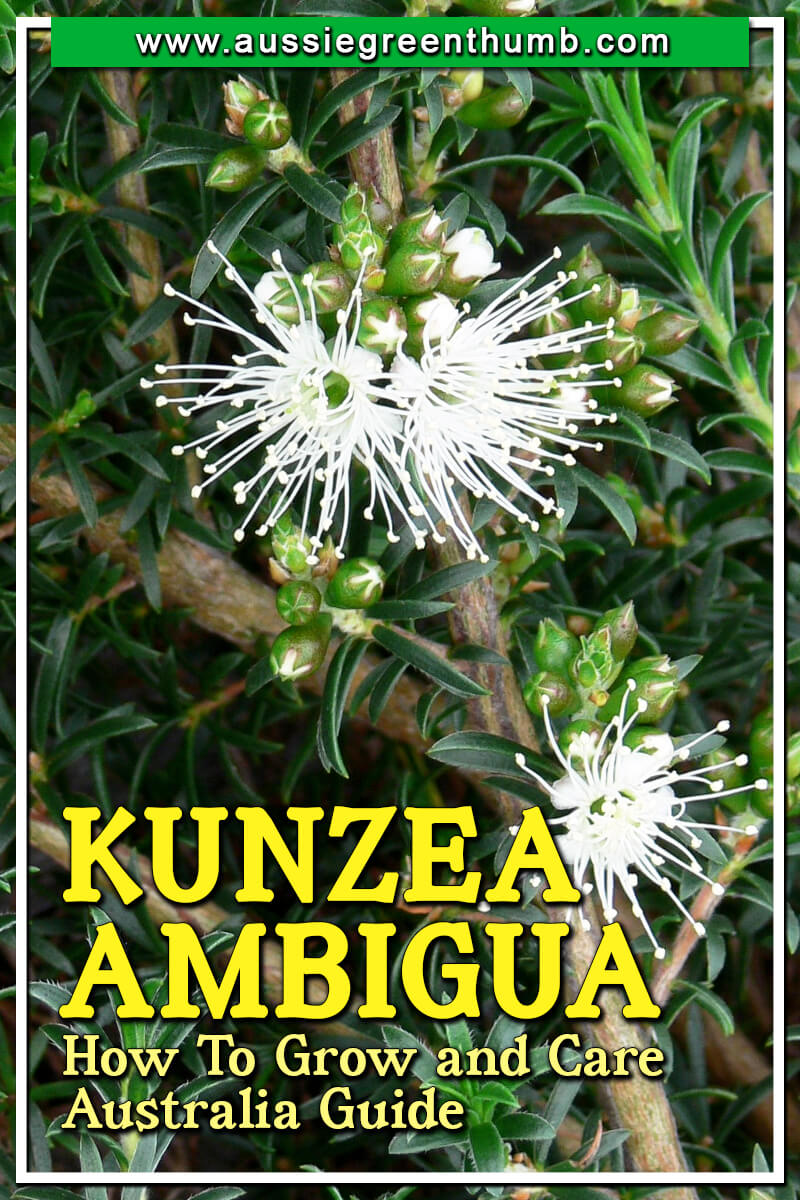
Add Some Summer Colour with Kunzea ambigua
This summer bloomer is a great Aussie native to choose. Due to its hassle-free care, it’s a great choice for beginner growers, and it will bring a bunch of fantastic garden visitors to your backyard.
For a real summer, spectacle considers growing some of the other Kunzea species alongside your Kunzea ambigua.
Published on January 15, 2023 by Gary Clarke
Last Updated on January 31, 2024

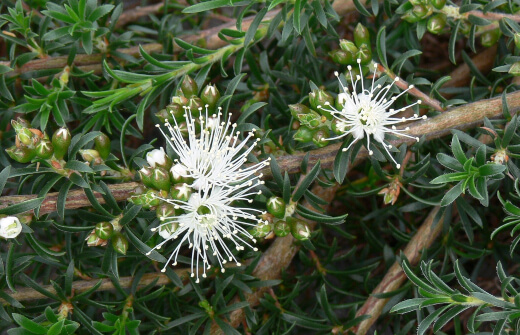

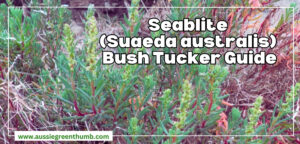
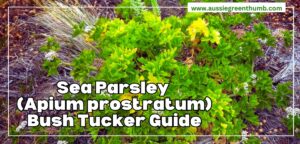
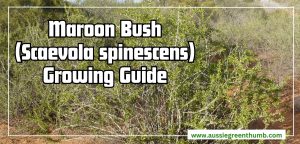
Good morning,
We live between Yass and the ACT border where, in winter, we can get the occassional -4 to -6 frost.
I recently bought a Kunzea in a pot ready to plant in spring but my husband tells me that the plant will not survive here – is he correct in this – should I take a chance and plant it or should I return it to the shop?
I look forward to your reply (in the hope that he is wrong).
Regards,
Vonne
Hi Vonne,
Thanks for the question.
Your Kunzea should be able to survive shorter periods in those temperatures. These hardy natives are frost resistant down to -5°C, which happens to fall in the middle of the temperatures you’ve outlined, so I understand the concern.
As they are best grown outdoors for their need for sunnier positions, I would recommend trying to plant your young Kunzea in the most frost-resistant location in your garden to start. Meaning somewhere with some shelter from other nearby trees or plants, or perhaps a position near a boundary or wall in your landscape.
There are also many frost covers available online and in-store that you can wrap around your plant during colder nights. Harder covers like plastic-based options will need to be staked around your plant to keep it from touching and suffocating your foliage.
Softer cloth-based covers can simply be wrapped lightly around your plant. Cover your Kunzea before nightfall when needed if temperatures drop too low for your liking. Be sure that the covers extend to the soil for the best results.
Alternatively, you can dig and plant the existing pot into your garden bed and dig it out on nights you feel may be too cold. You can then simply move the pot to a more protected and sheltered location around the house.
Once temperatures have warmed again, you can place your potted Kunzea back into the ground. This method will require some more effort and occasional repotting which may not be ideal on regular occurrences for your plant.
Ultimately, it is your decision whether or not you want to return your plant to the store. I hope I’ve managed to outline a few reasons why it could survive there but if you’re not entirely comfortable, there are many other beautiful native flowering plants to choose from that are more resistant to frost. Banksias, Callistemon, grevilleas and hakeas come to mind.
Happy gardening!
Gary Clarke